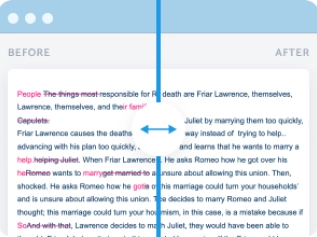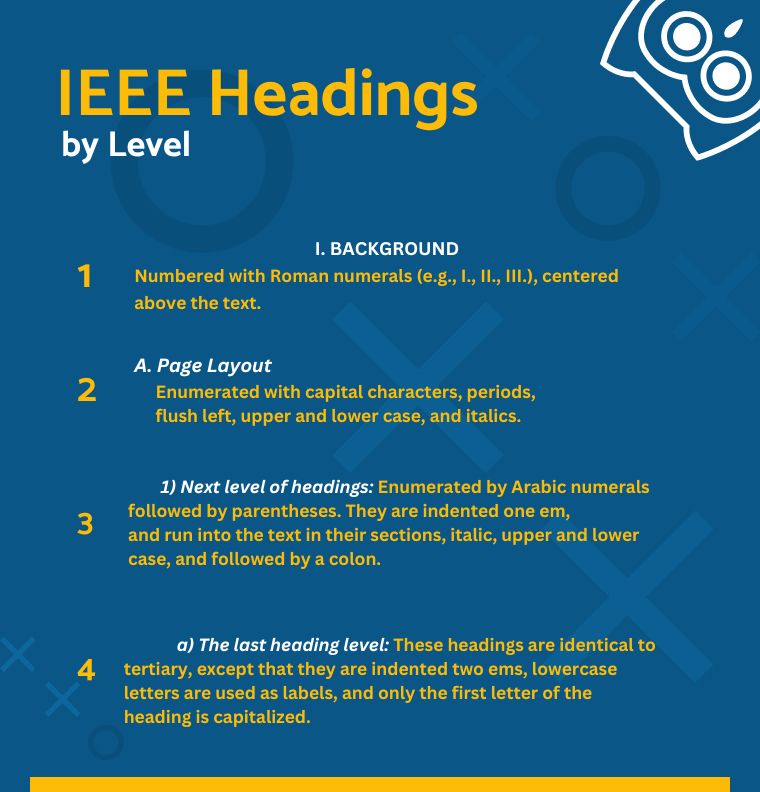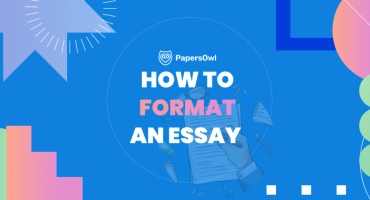IEEE Paper Format: Referencing Guide for CS and Engineering Research Papers
Table of contents
Navigating the intricate requirements of IEEE formatting can be daunting for both novice and experienced writers alike. Our article is designed to guide students and researchers through the intricate process of ensuring their scholarly work adheres to the rigorous standards set forth by IEEE writing style.
- In this article, we will explore the genesis and paramount importance of the IEEE style in academic circles.
- After reading the article, you will know about the main components of IEEE formatting.
- Look through the formatting guide on structuring your paper to mirror IEEE formatting guidelines focusing on layout, typography, and technical notation.
- An expansive review of citing a diverse range of sources and an IEEE research paper template.
Our goal is to arm you with the knowledge necessary to elevate the credibility and integrity of your academic pursuits. By emphasizing IEEE, scholars establish the foundation for outstanding research documentation, as well you can also use tools like the IEEE citation generator for precision.
What Does IEEE Stand For
The Institute of Electrical and Electronics Engineers (IEEE) citation style is more than just a set of guidelines for referencing sources; it’s a testament to the evolution of a discipline at the intersection of technology and research. Emerging from the need to standardize the documentation of sources in technical fields, the IEEE citation format has become synonymous with clarity, precision, and consistency in academic writing.
The IEEE citation style was developed in conjunction with the founding of the IEEE, an organization committed to the progression of technology for the benefit of humanity. This citation system was designed to meet the growing demands of the expanding fields of computer science and engineering, providing a structured method to cite diverse sources, including technical reports, conference proceedings, and electronic resources. Its creation was influenced by the principles outlined in the Chicago Manual of Style, ensuring a comprehensive approach to referencing that aligns with the specific needs of these technical disciplines.
Unlike the broader applicability of styles like APA and MLA, IEEE’s format is meticulously crafted to suit the technical and numerical nature of engineering literature. Its emphasis on concise, numbered references allows for seamless integration of citing sources without disrupting the flow of technical discourse.
When juxtaposed with APA formatting or MLA formatting, the IEEE format is distinguished by its use of square brackets for in-text citations and a streamlined reference list that prioritizes efficiency and accessibility. This strategy enhances the ease of source navigation and emphasizes the IEEE style’s commitment to conciseness and accuracy, establishing it as the go-to citation method for engineering research documentation. By comparing IEEE vs. APA, it’s clear that IEEE’s streamlined and precise citation approach is tailored for the engineering fields, in contrast to the APA style, which caters to a wider range of disciplines with its own set of guidelines that prioritize different aspects of citation and formatting.

Key Components of IEEE Style
The IEEE citation style, revered for its precision and applicability in technical fields, offers a structured approach to documenting sources. This section provides you with the essential elements that constitute its backbone.
In-text Citations
At the heart of IEEE’s in-text citation methodology is the use of square brackets containing numbers that correspond to a numbered reference list. This system ensures that citations are minimally intrusive, allowing the technical narrative to proceed uninterrupted. Each source is cited numerically, in the order of appearance, which simplifies reference management and reader navigation.
Reference List
The cornerstone of IEEE papers, the reference list is meticulously organized at the document’s conclusion. Each entry is numbered to match its in-text citation, following a specific format that includes the author’s name, paper title, publication date, and other relevant details, depending on the source type. This organization method supports the efficient retrieval of information and acknowledges the contributions of others in the researcher’s work.
Figures and Tables
IEEE guidelines stipulate specific formatting rules for figures and tables, including sequential numbering and the inclusion of descriptive captions. These elements should be referenced within the main text by their designated number, ensuring that each figure or table is easily identifiable and can be quickly referenced by readers. It means that figures, tables, and equations should each be numbered consecutively but separately.
Formatting Your Paper According to IEEE Guidelines

To write a research paper correctly, adhere to the following structured guidelines on how to write an IEEE paper:
- Title of the Paper: Position the title at the top center of the first page, utilizing an IEEE font size of 24pt.
- Author Details (Byline): Immediately below the title, centralize the byline in 10pt font, with each of the following details on its own line: author name(s), affiliation(s), city and country, and email address(es).
- Body of the Paper: The body text should be in 10pt font, formatted into two columns per page. Ensure that the columns on the final page are equal in length, possibly requiring a column break adjustment.
- Begin with an abstract followed by index terms.
- Papers might include additional sections based on the topic, such as Acknowledgments, Appendices, Note to Practitioners, and Nomenclature.
- Divide the main content into sections and subsections with appropriate headings.
- Number all tables, equations, and figures sequentially, ensuring they are centered within the column.
- Initiate the paper with a two-line deep drop cap, followed by the next 8-12 characters or 1-2 words in capital letters.
Parts of the Paper:
- Headings should follow a four-level hierarchy. The formatting includes centered primary headings with Roman numerals, flush left secondary headings in uppercase and lowercase italics, and indented tertiary headings with Arabic numerals followed by a parenthesis. Quaternary headings are similarly indented but enumerated by lowercase letters.
- Enumeration of headings is optional, but consistency is key.
- Distinct formats apply to IEEE Appendix, Reference, and Acknowledgement headings, which differ from the main text headings.
General Layout and Typography
The IEEE style mandates a specific formula for the layout, including font size, typeface, margins, and a column break. This structured approach ensures that each data point within your document — for example, if it’s a figure, table, or paragraph — receives the appropriate emphasis and weight, similar to how weights are considered in a weighted average calculation.
Title Page and Abstract
Structuring the title page and crafting an effective IEEE abstract is a simple process, yet it holds significant weight in how readers perceive and understand your research. Here, the average value of your work is summarized, offering a snapshot of your data set and the final average number representing your study’s conclusions. By the way, the incorporation of abstract and index terms within IEEE format publications significantly enhances the accessibility and discoverability of scholarly works.
Section Headings and Subheadings
Effective use of both a primary heading (or primary headings) and subheadings acts as a method for dividing your paper into manageable sections, each with its own relative importance and weight in the total grade of your research.
This organization aids readers in navigating your paper, similar to how one might calculate a weighted average to determine the importance of different values in a data set. In IEEE style, appendix headings should be put in a different system but should be written like main headings. If there is only one appendix, it should be labeled “Appendix.” If there is more than one appendix, each one should have its own number and title, which should be different from how the section titles are named.
Technical Content
Incorporating technical content, such as formulas, equations, and technical notation, requires precise calculation and accuracy. Each data point and formula used must be calculated with precision, mirroring the accuracy needed when calculating weighted averages in data analysis.
The precision and clarity required in calculating the weighted average or average price of commodities mirror the meticulousness needed in formatting academic papers according to IEEE guidelines. Every data point — from the IEEE title page to the IEEE reference page — must be considered with its relative importance in mind, ensuring the total weight of the document is balanced and well-structured. However, if you don’t have enough time for it, you can get help from a research paper writing service, where professionals will do everything according to all rules and guidelines.
Сheck my paper

Citing Sources in IEEE
Citing sources accurately in academic writing, particularly under the IEEE style, is a cornerstone of scholarly integrity and a testament to the meticulous nature of research within engineering disciplines. This meticulous approach ensures that every piece of information borrowed from another’s work is duly acknowledged, allowing readers to trace the origins of ideas and data, thereby fostering a transparent and ethical academic environment.
As we delve into the nuances of citing sources in IEEE, it becomes evident that this style is tailored to meet the specific needs of technical and scientific disciplines, offering a clear, concise, and systematic method of referencing.
Journal Articles
Citing journal articles in IEEE requires attention to detail. The format typically includes the author’s name, the title of the article, the title of the journal or newspaper article, the numbering system (volume number, issue number, page number or numbers), and the year of publication, all neatly encapsulated within square brackets.
This method highlights the importance of each element, ensuring readers can easily locate the original work. For example, a journal citation in IEEE might appear as follows: [1] A. Author, “Title of Article,” Title of Journal, vol. XX, no. XX, pp. XX-XX, year.
Conference Papers
We cite a conference paper, which is pivotal in disseminating cutting-edge research and findings with a similar level of specificity. The citation includes the author’s name, title of the paper, title of the conference, location, and the date of the conference. By providing a comprehensive citation, IEEE allows readers to explore the breadth of discussions and innovations presented in these professional gatherings.
Books and Chapters in Edited Volumes
When citing books and chapters within edited volumes, the IEEE writing format incorporates details such as the chapter author, chapter title, book editor, book title, edition (if applicable), publisher, city of publication, and the year. This exhaustive approach ensures that sources are credited with the utmost accuracy, reflecting the depth and breadth of research undertaken.
Electronic Sources
In today’s digital age, citing electronic sources — ranging from online databases to software and websites — has become increasingly common. IEEE adapts to this trend by requiring the URL or DOI (Digital Object Identifier), along with the standard citation information. This adaptation underscores the style’s flexibility and relevance in contemporary research practices.
Multiple Authors and No Author Situations
IEEE also provides clear guidelines for citing works by multiple authors or works where the author is unknown. For multiple authors, the style suggests listing all authors up to a certain number before resorting to “et al.” for brevity. In cases of no author, the title of the work moves to the author’s position in the citation, ensuring even anonymous works are appropriately acknowledged.
Tips for Avoiding Common Citation Errors
Navigating the intricacies of IEEE citations can be fraught with potential pitfalls, but mastering this component of academic writing is essential for maintaining scholarly integrity and ensuring the accuracy of your research or essay writers can do it instead of you.
Yet to fortify your work against common citation errors, consider these pivotal strategies:
- Accuracy in the details of each citation is paramount. Ensure that author names, titles, publication years, and page numbers are correctly noted and correspond precisely to the referenced material. A single discrepancy can lead to misattribution or difficulty in source retrieval.
- Apply the IEEE paper format uniformly throughout your document. Inconsistencies in citation style can confuse readers and detract from the professionalism of your work. Whether citing, for example, journals, books, or electronic sources, adherence to a consistent format is crucial.
- While citation management tools offer significant convenience, they are not infallible. Always review the generated citations for accuracy, ensuring they align with the latest IEEE standards.
- Misrepresenting authorship, especially in works with multiple authors, is a common error. Familiarize yourself with IEEE’s guidelines on listing authors to ensure proper attribution and to avoid unintentional omission.
- IEEE guidelines can evolve. Staying informed about the latest updates and revisions is essential for maintaining citation accuracy across all your academic endeavors.
Using IEEE Citation Tools and Software
Leveraging citation tools and software can dramatically streamline the process of adhering to the IEEE paper format, a boon for researchers and students alike. These technological aids, such as Zotero, Mendeley, EndNote, and LaTeX, offer robust support for generating and managing citations efficiently, ensuring compliance with IEEE standards. By automating the citation process, these tools minimize manual errors and save valuable time.
Zotero and Mendeley, for example, are renowned for their user-friendly interfaces and ability to organize references in a centralized library. They allow for the easy insertion of citations into documents and the automatic generation of reference lists, all while offering the flexibility to switch between citation styles, including IEEE.
LaTeX, with its BibTeX extension, is particularly favored in the engineering and information technology communities for its precision in handling complex documents and formulas. It excels in creating documents that adhere to the stringent formatting requirements of IEEE, especially for mathematical content and technical papers.
EndNote stands out for its wide-ranging database access and sophisticated reference management capabilities, making it a valuable resource for extensive research projects requiring IEEE formatting.
Final Words: Embracing IEEE for Academic Excellence
Mastering the IEEE style is not merely about adhering to a set of formatting rules; it’s about ensuring the weighted average of your research — each data point, calculation, and value — is presented with the utmost accuracy and precision. Like calculating weighted averages in complex datasets, applying IEEE guidelines requires attention to detail, method, and accuracy. Embrace these principles to enhance the value and integrity of your academic endeavors in engineering.







